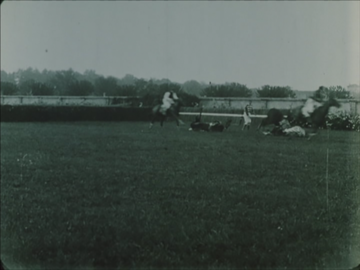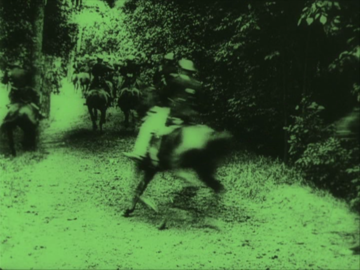Only Fools and Horses
Franz Kafka loved movies. He went to the movies often and wrote about them to friends and in his diaries. From these sources, Hanns Zischler has constructed a Kafka film library: a list of movies that Kafka must have seen. Zischler’s research was turned into a book and later a DVD collection, both entitled Kafka Goes to the Movies. The film collection consists of all but one of the movies that are still in existence. It comprises four DVDs of silent films from 1907 to 1921 and ranging in length, in their extant versions, from 2 minutes to 99 minutes. Documentary, comedy, drama, history: it’s all there. The collection is not only a fascinating look at the beginnings of film and at this moment in (especially European) time, but these movies also help turn the spotlight on some fascinating aspects of Kafka’s writing.
We’re no longer used to the ubiquity of horses. But in these films, they are still everywhere. Often their presence is mundane, waiting for someone to get into a carriage for example. But at other times, they provide drama or comedy, or both. Some of the most memorable horses in these films are part of tragi-comic scenes that equal Kafka’s best short stories.
One of my favourite films in the Kafka DVD collection is Peschiera / Lago Maggiore / Liguria / Il corse de Mirafiori also known in English as Italian Travel Pictures. It starts quietly and innocently with beautiful shots of Italy from the water. There are no people in sight here; the only hint at the presence of others is a wonderful tracking shot of a tramcar, camera on the water, tram on land. But when we get to the Mirafiori hippodrome, this silence and stillness disappears. Suddenly, people are everywhere. Masses of people are looking at the horses on the course. And it’s the horses that provide most of the action: first in a straight-forward race, then in a steeplechase.
I can’t say I know all that much about steeplechases, but I suppose they are not meant to all but destroy the barriers. Yet, this is what happens in the chase, and it’s rather comic. Rather than jumping over the obstacles, they go through it. This comedy becomes tragi-comic when, at another hurdle, two horses go down partly tripping over each another, but it becomes clear that one rider seems to get seriously hurt.

Still from Italian Travel Pictures (1907), with two horses and their riders down.
Kafka also wrote a story about a jockey. It is about a jockey who wins, which should already give us pause: when does a Kafka character ever succeed? Indeed, the win isn’t what one would expect. In ‘For Gentlemen-Riders to Think About’ (Zum Nachdenken für Herrenreiter), we learn that winning is lonely: your opponents envy you and immediately focus on the next, surely more important, race; your friends are either calculating the money they won or, the better friends, are angry that they did not put money on you, as, in that case, should you have lost, they would have to be angry at you. To the women, you look ridiculous in your new-found glory while hardly being able to cope with shaking all the hands that come your way, especially since your opponents by contrast are quietly comforting their horses. It also starts to rain.
None of this is to be seen in Italian Travel Pictures. But there, too, the winning jockeys are all but neglected. The first race mentions the winning horse in the title card – Sambar, should you want to know – but not the name of the jockey. And all we see of this jockey post-victory is getting off the horse, for the horse to be framed all by itself in front of a balcony of what seems to be important people. Similarly, the winner of the steeplechase is never mentioned. The fame in the steeplechase, in the film at least, is for the fallen jockey. He is whom the camera follows; not the end of the race or its victor. The fallen jockey is surrounded by men, too, who make sure he is alright. Something to reflect on, perhaps, for ‘Gentleman-Jockeys’.
One of Kafka’s shortest stories, ‘The Wish to Be a Red Indian’ (Wunsch, Indianer zu Werden) originally published in 1913, consists of only a single sentence:
Oh to be a Red Indian, ready in an instant, riding a swift horse, aslant in the air, thundering again and again over the thundering earth, until you let the spurs go, for there weren’t any spurs, until you cast off the reins, for there weren’t any reins, and you scarcely saw the land ahead of you as close-cropped scrub, being already without horse’s neck and horse’s head![1]

Still from Theodor Körner (1912) with, on the left, a horse galloping into a tree.
Critics have sometimes read this piece of flash fiction in the manner of futurist literature. Like in the paintings of Umberto Boccioni or Giacomo Balla, Kafka’s description of the heath shows how speed of movement blurs our perception of the world. The descriptions of quivering over the ground or the German construction of leaning in the air (trans.) are more suggestive of flight than of a ride on a horse. And the single sentence with its multiple subclauses, suggests a similarly speedy dynamic. The disappearance of the horse altogether might be an extension of this idea. At the same time there is a kind of yearning for a simpler existence, more at one with nature and more adventurous too. It is, after all, a fantasy. And yet, in Kafka things are always a bit clumsier than that. Too much ambition is almost always resisted if not punished in Kafka’s stories. And with the film in mind, I can’t help but think that all is not well here. The fantasy and ambition to ride like an Indian, to get rid of the spurs and shed the reins, seems like just the thing to be punished by Kafka. Does the horse disappear because of a blurry vision or a wavering fantasy, or maybe because, in fact, you are actually flying? Might we be catching the fantasy-jockey in mid-air here, thrown off by the horse? Is he or she, like Wile E. Coyote long past the edge of a cliff, not yet quite realising, even in his or her own fantasy, that the horse is actually no longer there?
Indeed, the horse-accident in Italian Travel Pictures does not stand on its own in the Kafka film collection. In another film, a piece of fiction this time, another accident happens. The eponymous film commemorating the centenary of Germany’s war hero and poet Theodor Körner’s death in 1913 famously has a large troupe of soldiers galloping through a narrow forest path. Then one rider and horse don’t quite make the turn and, famously, ride straight into a tree. Curiously, the accident wasn’t cut from the movie; but, indeed, the accident adds a touch of recognisable misfortune and thus of reality to an otherwise hagiographic story, quite like how Kafka’s own stories can be, despite their often strange worlds, so recognisable in the misfortunes of their heroes.
Kafka is known for his stories of animals: the undetermined ‘vermin’ in The Metamorphosis, the ape in ‘A Report to an Academy’, the canine in ‘Investigations of a Dog’ to name but a few. If these animals often stand in for the human experience of alterity, that is, for feelings of not-fitting-in, then horses in Kafka’s stories are often an extension of humans. They seem to signify the speed of modern existence, being taken along for the ride, and the unsteady environments that might at any moment be pulled from underneath you like a rug.
Meindert Peters is a Leverhulme Early-Career Research Fellow in the Faculty of Medieval and Modern Languages and Junior Research Fellow at New College, both at Oxford. His research studies the moving body in literature, dance, and thought.
[1] Kafka, Franz. ‘Wish to become a Red Indian’, The Complete Stories, trans. Joyce Crick. Oxford: Oxford University Press, 2009, p. 15.
hurt.


